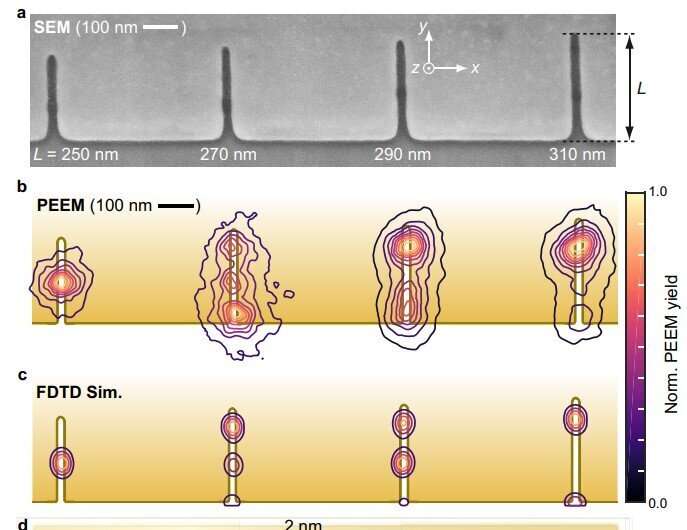This article has been reviewed according to Science X's editorial process and policies. Editors have highlighted the following attributes while ensuring the content's credibility:
fact-checked
peer-reviewed publication
trusted source
proofread
When the light is neither 'on' nor 'off' in the nanoworld

Whether the light in our living spaces is on or off can be regulated in everyday life simply by reaching for the light switch. However, when the space for the light is shrunk to a few nanometers, quantum mechanical effects dominate, and it is unclear whether there is light in it or not. Both can even be the case at the same time, as scientists from the Julius-Maximilians-Universität Würzburg (JMU) and the University of Bielefeld show in the journal Nature Physics.
"Detecting these exotic states of quantum physics on the size scales of electrical transistors could help in the development of optical quantum technologies of future computer chips," explains Würzburg professor Bert Hecht. The nanostructures studied were produced in his group.
The technology of our digital world is based on the principle that either a current flows or it does not: one or zero, on or off. Two clear states exist. In quantum physics, on the other hand, it is possible to disregard this principle and create an arbitrary superposition of the supposed opposites. This increases the possibilities of transmitting and processing information many times over. Such superposition states have been known for some time, especially for the particles of light, so-called photons, and are used in the detection of gravitational waves.
Quantum states detected
A team of physicists and physical chemists from Bielefeld and Würzburg has now succeeded in detecting such superposition states of light directly in a nanostructure. Light is captured in a nanostructure in a very small space and couples to electronic oscillations: so-called plasmons. This allows the energy of the light to be held in place on the nanoscale.
In the experiment in the group of Würzburg professor Tobias Brixner, the researchers investigated how many photons from a light pulse couple to the nanostructure. The result: simultaneously no photon and three photons. Brixner explains, "Detecting this signature was an enormous challenge. Photons can be detected very well with sensitive detectors; however, in the case of single photons, which are also in a quantum mechanical superposition state, suitable methods did not exist in the nanoworld." In addition, the coupled states of photons and electrons survive for less than a millionth of a millionth of a second and then decay again, leaving hardly any time for their detection.
Highest spatial and temporal resolution combined
In the experiments now published, a special detection was used. "The energy released during the decay of the state is sufficient to release other electrons from the nanostructure," explains Professor Walter Pfeiffer (Bielefeld), who played a key role in developing the physical model and interpreting the data. The triggered electrons could then be captured in an image using a photoemission electron microscope and a resolution of a few nanometers. Because of the fast decay times, sequences of ultrashort laser pulses were used to obtain the "fingerprint" of the superposition states of the light.
This is a first step toward the goal of analyzing the full quantum physical state of coupled photon and electrons directly at the nanoscale. A process that, as in medicine, is described by the term tomography. The light in the offices and laboratories of the scientists involved should thus clearly remain switched on.
More information: Sebastian Pres et al, Detection of a plasmon-polariton quantum wave packet, Nature Physics (2023). DOI: 10.1038/s41567-022-01912-5
Identifying the quantum fingerprint of plasmon polaritons, Nature Physics (2023). DOI: 10.1038/s41567-022-01925-0
Journal information: Nature Physics
Provided by Julius-Maximilians-Universität Würzburg




















